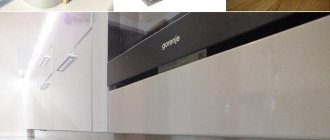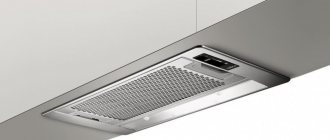Technique
3
6 159
Share
When designing a kitchen, high-quality ventilation is planned. This is necessary, since the air in the kitchen area is considered the most polluted in the apartment.
Original ventilation above the gas stove
- Why do you need to clean the air in the kitchen?
- What kind of fan is needed in the kitchen: how to choose the best option
- What to consider when purchasing a fume hood
- Additional functions
- Features of installing a silent device with a check valve
- Installing an umbrella depending on the location of the household structure
The kitchen exhaust fan is designed to regulate the balance of air exhaust and ensure its supply. In this case, forced removal of contaminated air occurs.
When choosing a device, the required power level and materials of construction are taken into account.
According to the rules, the kitchen is equipped with a device that changes the air about 12-15 times per hour. It is recommended to install the exhaust fan away from natural sources of air entering the apartment so that the device does not take in fresh air.
Benefits of a silent fan
The advantages of a silent fan include the following indicators:
- reduced amount of vibrations;
- low noise level;
- high performance;
- excellent quality of materials, assembly and components;
- convenient operation;
- easy installation.
The disadvantage of the device is the price, which is more than compensated by the listed advantages.
A hood in a bathroom or toilet with a built-in silent fan is a compact, multifunctional and energy-intensive device.
Colibri 100 – inexpensive among household ones
Lightweight, inexpensive axial type exhaust fan. Designed for air exchange in the toilet or bathroom, kitchen. Ventilates a dressing room, bathhouse or sauna. Mounted overhead in the ventilation duct, fastened to the wall using self-tapping screws.
The use of flexible air ducts is provided when the distance along the length is limited. Can be installed in a suspended ceiling. The device is operated in continuous or periodic mode. The fan is unpretentious and does not require special maintenance.
Pros:
- Lightweight, inexpensive, optimal power for a bathroom or toilet.
- Price, easy installation.
- Low noise level.
Minuses:
- Manual control.
Recommendations: 10 Best Ceiling Fans
15 Best Fans for Home
9 best bathroom fans
Why is there a fan in the bathroom?
A bathroom is a room in which the temperature and humidity are always elevated. According to current legislation, bathrooms in residential buildings must be provided with forced or natural ventilation. The accumulation of excess moisture in the air leads to corrosion and mold. The latter is the worst enemy for human health. Prolonged proximity to a colony of microscopic organisms leads to a deterioration in health. It is manifested by the following symptoms:
- headache;
- dizziness;
- diseases of the respiratory system;
- general exhaustion of the body.
Due to the wide range, the consumer often faces difficulties in making the right choice.
Since mold toxins fill the entire space, stale air first turns into an invisible “killer”, and then slowly poisons the apartment owners. By installing a silent exhaust fan in the bathroom, you normalize the level of humidity and temperature. By removing exhaust air, the device neutralizes dust particles, viruses, harmful fumes and carbon dioxide.
How kitchen ventilation works
In multi-storey buildings of the old type, the so-called Khrushchev buildings, ventilation shafts were built to remove warm and humid air. The created vacuum is replenished with clean air from the cracks in the doors and vents. Engineering communications pass through all floors and are located between the kitchen and bathroom. The grilles are mounted under the ceiling, in the walls, from where they exit directly into the shaft; additional air ducts are not used.
This device has several disadvantages. Air movement depends on external factors; in summer, ventilation is inactive. There will be no outflow even with hermetically sealed windows. The disadvantages also include low draft on the top floors of buildings.
Features of ventilation in old houses are presented in the story:
In panel high-rise buildings of later construction, the device operates somewhat differently. To disperse the air, so-called satellites were installed to a common shaft from each apartment. The connection to the central trunk saves space.
Ventilation of such apartment buildings has several features:
- complete dependence on weather conditions;
- air duct interconnection;
- The outflow of air is carried out from the most contaminated rooms, including the kitchen, and fresh air enters the living rooms.
Ventilation should work in such a way that 60-90 cubic meters of air are removed from one apartment within an hour. But in most apartments, the old windows were replaced with metal-plastic structures; complete tightness blocks access to clean air.
The kitchen will not acquire a healthy microclimate with frequent ventilation; this is an erroneous judgment. The problem will be solved only by controlled air exchange on an ongoing basis. Malfunction of the ventilation system leads to the following consequences:
- humidity levels increase;
- oxygen is replaced by gases, including carbon dioxide;
- soot settles on furniture and household appliances;
- persistent, stagnant odors appear in residential areas.
The full operation of utility networks depends on two factors - the removal of exhaust air and the influx of fresh air. Restoring or upgrading kitchen ventilation can be done independently in several cases. There are several ways to determine the effectiveness of a kitchen appliance.
Types of silent fans
Appliances for household hoods vary in design and installation location. By device type they are:
- duct;
- axial;
- radial;
- invoices.
There is another classification - according to additional functionality. The devices may have manual and electronic switching modes, light, motion and humidity sensors. The model range is also divided according to the installation location into the following categories: wall-mounted, ceiling-mounted and built-in.
Every bathroom has a ventilation system. However, many, especially during the renovation process, prefer to close it at the stage of finishing work.
Fans are also distinguished by design:
- with flat front panels;
- with backlight;
- with matte and glossy panel.
The unusual appearance of the device can become the highlight of the bathroom design.
It is recommended to install forced ventilation, which includes a silent fan.
About the channel
The device is installed at the base of the duct. Since the housing is not equipped with rubber elements, additional vibrations and noise occur during operation. Despite this design feature, the unit is much more efficient than a conventional fan.
A duct fan is one of the most effective ways to improve air exchange in a room.
About the axial
The impeller passes air in the direction of movement of the engine rotor. The device body suppresses 80% of noise.
An axial fan is found in almost every home today.
About radial
It is extremely rarely used in domestic conditions. Radial type devices can be found in the workshops of industrial enterprises. To install a ventilation system, you will need to make several channels, each of which will have a separate fan installed. The large-sized device produces minimal noise, but due to its large size it has become persona non grata in residential buildings.
A radial fan has a specific principle of organizing air flow.
About the invoice
The most commonly used exhaust fan model. It fits into the ventilation shafts of apartment and private buildings. The unit is easily installed by mounting it at the outlet of the ventilation duct.
Overhead bathroom fans are one of the most common types of fans for home use.
How to properly install an exhaust fan in the kitchen
You can install the fan yourself, but this procedure is quite painstaking and must be performed very carefully. A window fan, for example, can be installed at any time of the day or season. But it is better to provide for the wall fixture in advance, preferably at the stage of repair work, so that later imperfections on the wall can be successfully masked.
window type exhaust fan is installed in the kitchen as follows:
- select a location for installation. This should be the window that is closest to the hob, at the maximum height, the distance from the window glass should be at least 20 cm;
- Markings are applied to the glass that correspond to the fan’s performance. Using a glass cutter, cut a hole in the window in compliance with the diameter of the fan casing;
- Rubber protectors are installed on the casing, then the mechanism is mounted in the window opening;
- Attach the clamping strips to the outer flange, the screws are tightened as tightly as possible so that the structure in the window is well attached. Remains of pressure tapes must be removed;
- the working unit must be placed in the fan casing while maintaining a distance, and the blades should not touch the walls when rotating;
- The fan is connected to the mains and a test run is performed. If the mechanism works properly, you just need to install the internal protective grille.
If a person has already dealt with similar work, then installing an exhaust window fan will be short and simple.
How to install a wall fan :
- find the ventilation shaft in the wall, make sure that the ventilation is working properly;
- Using a hammer drill with a concrete drill, you need to drill several small holes in the wall. Then they connect, and as a result a large hole is formed;
- place the pipe in the hole, and then the fan itself is installed, after which it is secured with anchors - special fastening bolts;
- the fan is connected to electricity, checked for proper operation, then a protective grill is installed.
If the exhaust fan is installed on an external wall, the installation process will be the same as in the case of an internal wall. However, there is one addition - after all work is completed, the fan is covered with a protective grill not only from the inside, but also from the outside.
Fan sizes
Manufacturers produce models with different diameters. The volume of air masses removed directly depends on its size. The more air the device removes, the faster the condensation in the room disappears. But at the same time, the more often the fan replaces room air, the faster the bath “cools down” and becomes cold. The operation of the heating system at home can be negated by an incorrectly selected diameter of the device.
Important! Excessive performance of the unit leads to excessive consumption of thermal energy carrier.
After installing the fan, you will gain many benefits.
For a private house it is much more difficult to think through a ventilation scheme than for an apartment. Design organizations took on the headache of high-rise building residents. They made the necessary calculations even before laying the foundation. The owners of the living space just have to choose a bathroom fan that fits the size of the ventilation hole.
The minimum fan diameter size is 80 mm, and the largest is 200 mm. According to the standard, all device dimensions are multiples of 20 mm. The dimensions are directly related to the type of device design. The devices are produced in standard sizes:
- channel type – 200 mm;
- exhaust – 100 mm;
- axial – 125 mm.
With a fan, you will get rid of the problem of mold and mildew associated with high humidity in the room.
The configuration of the device is round, rectangular and square.
Important! The configuration of the unit must correspond to the shape of the ventilation duct.
Results and conclusions
To summarize the above, it is worth noting once again that any kitchen must be equipped with kitchen exhaust fans. This is primarily due to concern for your health and the health of the people in the room.
The article provided information about the purpose of exhaust devices and their types, and provided recommendations on power calculations and installation methods. We hope that the information presented will help you make high-quality and reliable ventilation.
Moisture resistance of the device
Devices are marked according to IP protection classification. The higher this indicator, the more reliable the device. The bathroom is a place where splashes and steam cannot be avoided. The household appliances present here are constantly in the “risk zone”. If the room is damp, electrical appliances may fail due to a short circuit. In order to protect household appliances, it is necessary to install fans with a moisture-resistant housing. The safety of the working elements depends on the material of its manufacture and the quality of assembly. The durable housing, which is hermetically sealed, prevents moisture from penetrating inside.
There will be no sudden temperature changes in the room if there is a home hood.
Important! When ordering a device, look at the IP marking. It contains letters and numbers. The first number indicates the degree of protection from mechanical damage and dust, and the second – from water. Choose a device with a higher number. The higher it is, the more stable the body is. The degree of protection leaves no chance for moisture, which can disrupt the operation of electrical parts.
Those who like to take long hot baths will benefit from a device that can withstand high temperatures. This category of fans operates smoothly at temperatures from 70 to 180o C.
Relationship between power and noise
Note that less powerful electrical appliances are usually less noisy. There may be an illusion that low-power devices have all the advantages over their more powerful “brothers”. It is not always so. Manufacturers who value their name take into account all the smallest parameters and in many ways can surpass their competitors. Even a very powerful fan from a reputable manufacturing association can be virtually silent. This is ensured by installing high-quality bearings in the fan, and not bushings, as is sometimes done.
And another important point that must be taken into account when choosing is ease of installation. A “sophisticated” fan may turn out to be so difficult to install that you will need to either seek the help of a specialist or sift through a huge amount of literature. But everything should be simple: choose - buy - install - use. What if it breaks? To do this, the technical passport indicates service centers that perform warranty repairs and post-warranty service.
Models with extended functionality
Ventilation hood devices are also divided according to the presence of additional options:
- check valve;
- closing blinds;
- timer;
- individual switch.
Each species is interesting in its own way.
The need to deal with unpleasant odors will disappear, as the air is constantly replaced.
Fan with check valve
The device prevents backflow of air. When it is not working, air masses from the ventilation duct do not flow inside. Installation of this model is recommended in high-rise buildings, where pressure differences are created between neighboring apartments, or air leakage occurs from a common ventilation shaft.
A practical, silent bathroom fan with a check valve quickly removes mustiness and unpleasant odors.
A fan with a check valve is also installed in houses where the hood goes directly to the street. Here the device not only prevents the influx of air masses from the outside, but also prevents the entry of dirt, dust, smoke, insects, allergens and small particles. Thanks to its design feature, the fan reduces heat loss that leaves the room along with the exhaust air.
Fan with timer
A practical and economical unit among its analogues. It not only takes care of the microclimate of the bathroom, but also reduces electricity costs. The device operates with a delay and responds to turning the light on and off. When the bathroom light is turned on, the fan starts after N amount of time. And when the light is turned off, it stops working after a few minutes. The timer is responsible for delaying the startup and shutdown of the device.
Bathroom hoods with a timer are very easy to use.
Time-based forced exhaust significantly reduces utility bills and extends the service life of the device. The delay range ranges from 3 to 30 minutes. You can set the delay time at your discretion. The timer block is reliably protected from splashes and foreign particles.
Battery powered fan
A quiet device that operates not from a battery, but from batteries. This model is appropriate in rooms with extremely high humidity and in places where it is difficult to connect it to the general power supply system.
The battery-powered device greatly simplifies the installation of the hood.
Fan with curtain
The unit with automatic blinds is an extremely simple device in design. It is equipped with an electric motor, which is responsible for the movement of the axis. The impeller blades rotate along with the axis. The low-noise fan, equipped with a curtain, is controlled by a special built-in drive. When the device is inactive, the blinds close, thereby preventing reverse draft and drafts. The following indicators are also attributed to the strengths of the model:
- compact dimensions;
- simple installation;
- minimal electricity consumption.
An automatic exhaust fan is suitable for families with small children and people who are prone to colds from the slightest draft.
Types of hood fans and which manufacturer to choose: review and comparison
It's no secret that in any permanently inhabited apartment, as a result of the life processes of its residents, foreign odors or strong humidity can form, which can make staying in the room not the most comfortable. Exhaust fans were developed to solve such problems. Today we will talk about what an exhaust fan is and what types it comes in.
What is it and how does it work?
An exhaust fan is an electrical device designed to remove unpleasant odors and moist air from a room. As a rule, such fans are installed in the kitchen, bathroom or toilet.
Principle of operation
In the vast majority of cases, household exhaust fans are made in the form of axial models - a wheel with blades is placed on the axis of the electric motor. The air is drawn into the device through a grille equipped with louvres that prevent reverse flow, then passes through the device and is discharged outside. This kind of fans can be installed in windows, and if there is an additional short air duct, some models of devices can be built directly into the wall.
In order to overcome the resistance of a long air duct, some fans are made in the form of centrifugal models - in this case, the impeller directs the air to the sides at right angles to the axis of the electric motor.
At the same time, radial models are most often used at industrial facilities.
Fans can operate both manually and automatically. In the first case, to start operating the device, you must turn on the device yourself using a cord switch, and in the second, the device is activated when certain conditions occur. These conditions may include reaching a certain humidity level, turning on a light, or ending a specified time period.
In kitchens, most exhaust fans are connected to a connection device equipped with a fuse. In the bathroom, the fan can be connected to a corded input, which in turn is connected to a fused connection device outside. Alternatively, the fan can be connected to the lighting circuit and controlled using a ceiling cord switch.
Power calculation
For the effective operation of any exhaust fan, proper calculation of its power is necessary. Otherwise, the device will not be able to remove the required amount of air from the room being served, and the fan efficiency will tend to zero.
The fan performance should be selected taking into account the type of room and the volume of air that needs to be removed. So, a kitchen fan should be able to completely replace the air in it at least 10-15 times per hour. For bathrooms, air changes are needed somewhat less frequently - only 6-8 times per hour, but if the bathroom has a shower, then the required figure will increase to 20 times per hour. For individual toilets, only 6-10 shifts are sufficient.
In order to calculate the minimum required power of an exhaust fan, you must first calculate the volume of the room served (height x width x length) and multiply it by the recommended number of air changes per hour.
So, for a small kitchen with a volume of 25 cubic meters, the required minimum capacity of the exhaust device is 25 m3 x 15 shifts = 375 m3 per hour.
The location of the fan also plays an important role. The whole point is that the air removed from the room must be completely replaced with fresh air - as a rule, through the door or other parts of the home. If the fan is located too close to the source of fresh air, it will only create local ventilation and will not have a significant effect on the rest of the air in the room. The ideal location is opposite the source of replacement air, but high enough to draw out the heated air.
Attention: In the kitchen, you should try to install an exhaust fan next to the stove - this will allow the device to easily remove odors resulting from cooking.
If there are devices with a chimney in the room, then it is necessary to properly ensure ventilation of such a room with an adequate flow of replacement air - this will not allow the turned on fan to draw combustion gases from the chimney back into the room. The only exceptions are devices equipped with balanced draft chimneys that draw in fresh air from outside.
If you have any doubts about the correct location of the device, you should consult a heating engineer.
Popular manufacturers of household hood fans
Today, the most popular brands of household exhaust fans are:
- "Vents": production: Ukraine;
- 100 m3 fan with rectangular front grille;
- seven-petal impeller;
- installation: on the ceiling or wall;
- body material: ABS plastic;
- silent operation;
- cost: about 1,500 rubles.
- production: Sweden;
- production: Spain;
- production: Russia;
- production: Germany;
Types and characteristics
Duct silent
A special feature of such devices is their installation directly into the ventilation duct, which allows them to be completely hidden from view. Duct fans ensure safe and silent operation.
Such a device is installed directly into the wall, and the remaining hole is covered with a special mesh. It is behind it that the air ducts begin, through which air masses pass from the room being served to the filtration system, where the air is cleaned and supplied back to the room using distributors.
Duct fans can be easily installed in the space between the suspended ceiling - this maneuver can significantly expand the possibilities of the interior.
Duct-type fans can be made in the form of round, rectangular, square and noise-absorbing centrifugal systems, which makes it possible to install them anywhere. At the same time, the latest models mentioned have a low background noise, so they can be installed even in bedrooms.
Axial
In axial exhaust fans, air moves not only centrifugally, but also parallel to the axis of rotation of the blades. They are distinguished from other modifications of devices by their relatively simple design and low noise level during operation.
As a rule, axial fans are installed as an addition to the main ventilation system.
Experts distinguish two types of axial fans: domestic and industrial.
Industrial fans are used in civil and industrial buildings where quite aggressive and explosive air can circulate.
To maintain rooms with clean air free of fibers, cement and other foreign substances, household axial fans are used.
Centrifugal
One of the most common types of fans used in residential and industrial premises is the centrifugal type of device.
Attention: The industrial centrifugal fan should not be installed if there are fibrous or sticky particles in the air.
Due to their one-piece construction, centrifugal fans are characterized by increased strength.
Such devices can be used at temperatures both -40 and +40 degrees.
Experts distinguish two types of suction in such devices: one-way and two-way. It should be noted that in the second case, operation of the device is allowed only at an air temperature of no higher than 60 degrees.
The operation of household centrifugal fans is based on the refraction of air masses by 90 degrees and their passage through a spiral wheel. This type of device requires the installation of a muffler, which will smooth out the noise they make.
With check valve
The check valve is a special blade with a diameter capable of completely blocking the working module from the rear. This blade is attached directly to the fan axis.
The valve is designed in such a way that it does not allow return draft (air previously drawn from the room) or air flow (from the ventilation duct or from the street) along with other contaminants.
When the device is turned on, the check valve opens, and when turned off, it closes.
According to the method of operation, a check valve can be automatic (most often used in domestic premises) or passive - that is, operating under the influence of air flow (used least often).
In addition, the check valve is classified according to other parameters:
- by type of installation: vertical and horizontal;
- by type of manufacture: plastic, silicone and metal;
- in shape: rectangular, round and in the form of blinds;
- by design features: axial and centrifugal.
Exhaust fan with timer
A fan equipped with a timer starts working after a person enters the room being served and turns on the light. After turning off the light, the device continues to work for some time. The duration of the device operation delay can be adjusted in a wide range. Such fans are used both in residential and public buildings.
Timers for exhaust fans have two operating modes:
- The device starts working when a control signal appears at the terminal, and turns off after the timer counts down a user-specified time interval after the control signal is turned off.
- The device operates throughout the entire time interval after the control signal is removed from the terminal, provided that its duration was more than 90 seconds.
It should be noted that the second method is more economical, since it allows you to reduce the frequency of fan switching on without any special need.
The device should be connected according to the diagram below.
Radial
Radial fans differ from other modifications in the spiral shape of the housing, inside of which a blade wheel is located. When the wheel rotates, air masses move in the radial direction, are compressed under the influence of centrifugal force and exit the housing.
The blades of the radial device can be directed both backward and forward. The first option will save up to 20 percent of electricity and significantly reduce the operating noise of the device. At the same time, blades directed forward significantly increase the operating power of the device, which affects both the economic and acoustic characteristics of the device.
The compact dimensions of radial models allow the device to be installed in almost any air duct.
"Snail"
The so-called volute hoods differ from standard fans with large blades by having small, specially shaped blades.
The speed and power of such devices can vary significantly depending on the number of blades and motor parameters.
The way the snails work is quite simple - when air gets inside the device, it is sucked into the rotor, begins to rotate and is subjected to pressure. At this time, the air is cleared of foreign elements and gradually moves towards the exit. Due to the general shape of the input and output channels, resembling a snail, the hood received its corresponding name.
By purpose: what type of fan and which manufacturer is better to choose
In the bathroom
The optimal solution for choosing an exhaust fan for the bathroom is to purchase a device with a built-in humidity sensor.
The most popular model is SILENT-100 CHZ from Soler & Palau.
Distinctive features of this model are:
- timer with delay;
- power consumption: 8 W;
- productivity: 95 m3/hour;
- sound pressure level: up to 26.5 dB (comparable to a human whisper).
However, for a large bathroom (over 4 m2 in area), you should select a more powerful model. For example, EAF-150 from Electrolux. This fan differs from other devices in the following parameters:
- productivity: 320 m3/hour;
- power: 25 W;
- Sound pressure level: up to 35 dB.
Kitchen
For a kitchen hood, you should select a fairly powerful model that can not only serve a fairly large room, but will also be able to operate at fairly high temperatures and not make a lot of noise.
One of the most suitable fan models for kitchen hoods is Wolter KA KATD 225-4 Stb, which has the following characteristics:
- productivity: 2,800 m3/hour;
- sound pressure level: up to 59 dB;
- power: 75 W;
- maximum temperature of transported air: 120 degrees.
In the toilet
The low-noise model SILENT-100 CZ from the previously mentioned one is suitable as an exhaust fan. This device has the following parameters:
- power: 8 W;
- productivity: 95 m3/hour;
- manual activation.
In the garage
For a garage, an excellent exhaust fan option is the STELS 150 model, which has the following characteristics:
- power: 126 W;
- productivity: 432 m3/hour;
- sound pressure level: up to 58 dB;
- maximum temperature of transported air: 40 degrees.
Installation: how to install correctly
The entire process of installing an exhaust fan can be divided into five stages:
- preparatory actions;
- connecting wires;
- location of ventilation ducts;
- installation of the structure;
- checking the functionality of the device.
When installing the device, there are a number of specific rules to keep in mind, including the following:
- ventilation efficiency is higher if there are slots in the door or there is a small gap between the door and the threshold;
- the air shaft must be checked for blockages;
- installation is carried out only after connecting the device to the power supply;
- the structure must fit tightly in the hole intended for it; if necessary, the hole must be expanded or narrowed using polyurethane foam.
Watch the video instructions on this topic:
Price
The cost of exhaust fans depends on the purpose of the device, its power, performance and the availability of additional options. Practice shows that the average price for household models fluctuates around two to three thousand rubles. Fans for industrial use are, of course, much more expensive.
Where to buy an exhaust fan?
In Moscow
In Moscow, you can purchase an exhaust fan from such organizations as:
- LLC "MARLEY-RUS": website: https://www.marley-rus.ru;
- address: Moscow, Leninsky Prospekt, building 15, office 101;
- telephone.
- website: https://www.rusklimat.ru;
- website: https://mypassage.ru;
In St. Petersburg
In St. Petersburg, the following companies sell exhaust fans:
- online store "INTERSTROYVENT": website: https://www.isvent.ru;
- address: St. Petersburg, Piskarevsky Prospekt, building 2, building 2, office 215;
- telephone.
- website: https://www.vents-spb.ru;
- website: https://klimatweb.ru;
Thus, when choosing an exhaust fan, you should take into account all the necessary parameters of the room and operating conditions of the device. Otherwise, installing a fan may be completely useless.
Aug 18, 2017ventsyst
Which device should I buy?
When choosing a bathroom fan, consider the following characteristics:
- workmanship;
- location;
- type and size of the ventilation duct section;
- performance;
- additional options;
- noise level;
- design.
To determine the performance of the device, it is necessary to calculate the exhaust ventilation based on the air exchange rate. This concept refers to the number of times the air is replaced with fresh air in one hour. For the calculation, take the area of the bathroom, and the air exchange rate is equated to 7 times.
If the fan is installed correctly, then there should be no problems with its operation, and it will effectively cope with the amount of air intended for it in the room.
For example, you have a bathroom with an area of 5 m2 with ceilings of 2.75 m. This means the volume of the room is 13.75 m3. Multiply the resulting value by 7. The result will be the required fan performance.
All devices produce noise from air movement or vibration of working elements. Its level depends on the configuration of the housing, the impeller and its rotation speed. The more successful the combination of these factors, the quieter the device operates.
Based on the room, its dimensions and the preparation of the ventilation shaft, you can choose the right fan.
Important! The higher the performance, the louder the sound produced.
For a standard bathroom with an area of no more than 9 m2, models with an air exchange rate of up to 100 m3/h are used. In this case, the noise will be minimal. But if the apartment has a large bathroom, then you will need a more powerful unit, which causes more noise. To reduce the noise pressure level, it is necessary to select the appropriate fan operating mode. For example, a high-performance model with a timer is suitable.
If you don’t know which fan is best to choose for your bathroom, rely on the popular models from the rating below.
By installing the fan correctly, you can make your stay in the bathroom comfortable and enjoyable.
RVS Electra 125 – channel
Supply and exhaust fan of duct type. Mounted in a ventilation shaft or round air duct. High-quality moisture-resistant ABS plastic is used. The electric motor is designed for long-term operation and is economical.
The device is used in a bathroom, shower or bathroom, kitchen, and other small rooms. The operating principle is axial. It has a simple design, is unpretentious, and does not require special preventive maintenance work.
Pros:
- Duct, convenient to install in a round air duct.
- Economical, can work without interruption for several hours.
- Performance, low noise, good quality plastic.
Minuses:
- No negative properties were noted by consumers.
Installation Tips
Before installing a new fan, you will need to dismantle the old one. It goes in the following order:
- de-energize the device from the mains;
- remove the cover;
- disconnect the wires from the power terminals;
- unscrew the holding screws;
- remove the device from the ventilation shaft.
For safe operation, as well as collection and further removal of condensate, many manufacturers add a special tray to the fan kit.
When the fan is glued to the plate, carefully dismantle the housing without widening the ventilation duct hole.
TDM 100 SQ1807-0201 – People's series
Wall series fan. It is used to remove polluted air from small domestic premises. Power supply: 220 volt network. The device is classified as People's. Installed in a ventilation duct with fixation to a wall, partition, suspended ceiling or ceiling.
Proper weight distribution, durable blade materials with a certain degree of plasticity, made it possible to achieve acceptable efficiency while maintaining performance. Has low noise.
Pros:
- A household axial fan that fully performs its basic functions.
- Lightweight design, easy installation, unpretentious.
- Cute, low noise.
Minuses:
- The check valve must be purchased additionally, as well as the electronics for automatic operation.
TOP 5 silent fans for the bathroom
The top five were headed by devices of different classes.
Fans of modern technology will like fans with a variety of sensors and lighting.
SILENT-100 CZ
The model provides excellent air exchange. The body is made of high-quality plastic, which does not lose its original appearance for a long time. Power is up to 90 m3/h, noise is up to 26.5 dB. When it works, only the sound from the movement of air is heard, and not the hum from the impeller.
Elicent Style 100 PRO
Fan with check valve from an Italian manufacturer. The main feature of the design is the suction of exhaust air from four sides. The performance of the unit is the same as that of the SILENT-100 CZ, but the noise level is higher - 31.4 dB.
The option of a corded switch and timer can be added.
Standard 4ETF
Fan with photo timer, powered by a photocell. The model is used for periodic and continuous exhaust, since the power is 100 m3/h. Accordingly, the noise level is higher - 35 dB.
Motors mm-100
An ultra-thin and incredibly quiet unit from a Bulgarian brand. It can withstand extremely high temperatures and produces a barely audible sound during operation. The disadvantage of the device is its low productivity of up to 60 m3/h. Suitable for small spaces.
The design mostly has only positive reviews.
EBB-250NS
High-performance model of a surface-mounted centrifugal fan. This type of device will be needed for a ventilation system with increased resistance in the duct.
The rating brings together the best devices of their kind. Choose a high-quality fan so that the hood works smoothly and the necessary microclimate is maintained in the bathroom.
Design and principle of operation of the fan
Kitchen fans are electrical devices, an integral part of which is an electric motor and a propeller with blades attached to it.
When the device is connected to the power supply, the blades are set in motion, drawing in and pushing out air. Most kitchen fan systems have a feature that prevents air from blowing back into the room.
This is achieved through a special check valve, which allows the air flow to pass through itself to the outside and blocks its reverse flow.
The valve is a damper that closes when the device is turned off, i.e., when there is no air pressure.
There are various models on the market, from simple to “smart”. In the first case, the devices have nothing superfluous, only basic structural elements.
In the second case, they are equipped with various sensors and are capable of operating in automatic mode.
Such devices are activated under specified conditions, for example, when a certain temperature or humidity is reached, a light turns on, a timer goes off, etc.
All kitchen hoods must be equipped with ventilation devices. To avoid overloads and for safety reasons, each of these devices is equipped with a fuse.










